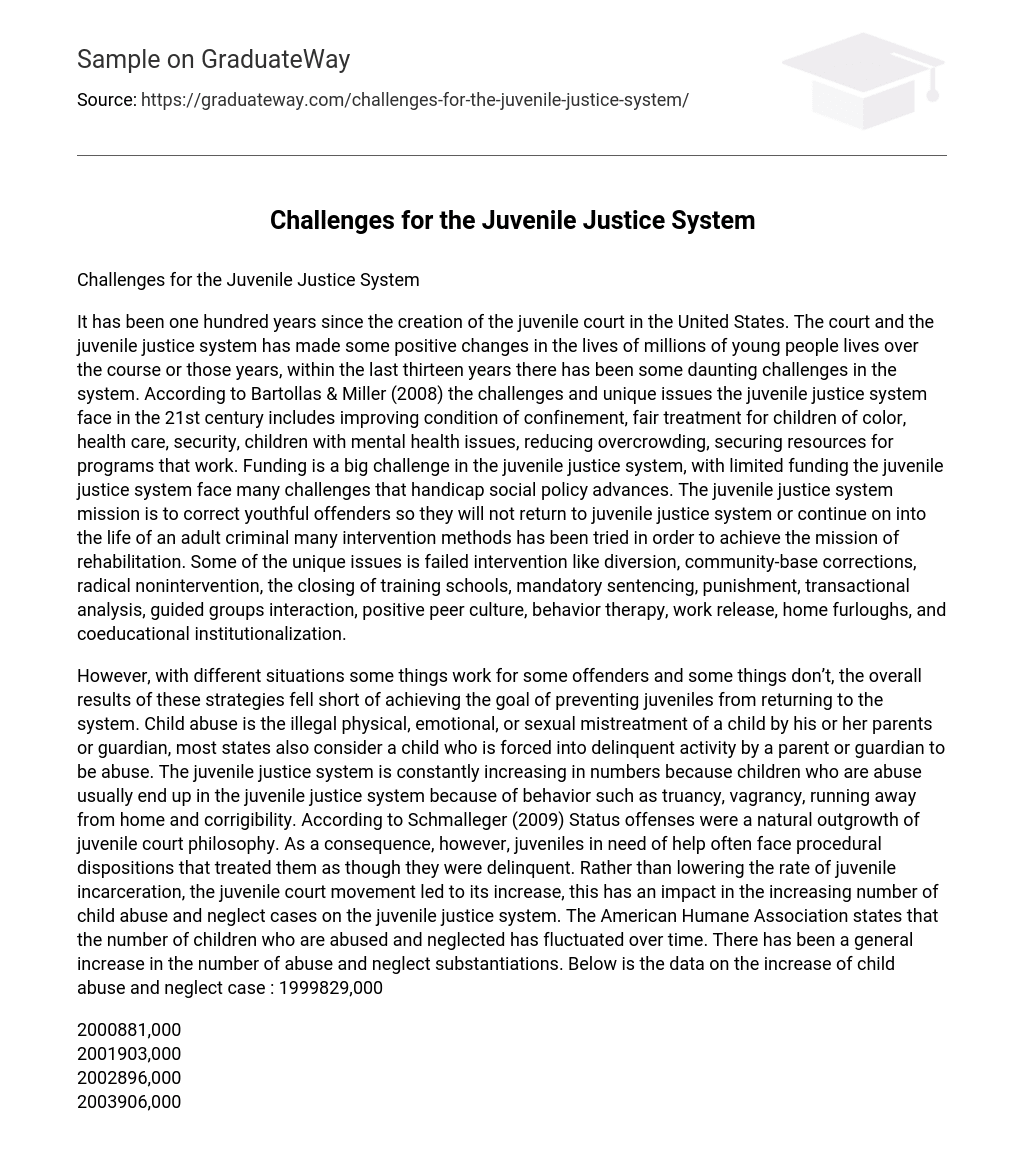One hundred years have passed since the creation of the juvenile court in the United States. Despite its positive impact on young people’s lives, there are significant challenges facing the court and the juvenile justice system. Bartollas & Miller (2008) identify these challenges as improving confinement conditions, ensuring fair treatment for children of color, addressing healthcare and security concerns, dealing with mental health issues among children, reducing overcrowding, and securing resources for effective programs. Limited funding remains a major obstacle that hinders progress in social policy.
The primary goal of the juvenile justice system is to rehabilitate youthful offenders to prevent them from returning or continuing down a path towards adult criminality. Various methods have been attempted to achieve this mission, including diversion programs, community-based corrections, radical nonintervention approaches, closing training schools, mandatory sentencing measures, punishment strategies, transactional analysis techniques, guided group interaction interventions, positive peer culture behavior therapy practices work release home furloughs and coeducational institutionalization.
Unfortunately, different situations result in different outcomes for offenders, making certain strategies effective for some but not others. Regrettably, these strategies have not successfully achieved the objective of preventing juveniles from reentering the system. Child abuse refers to the illegal mistreatment of a child by their parents or guardian and includes physical, emotional, or sexual forms of abuse. Additionally, coercing a child into engaging in delinquent activities is considered a form of abuse by many states. Consequently, there has been an increase in the number of children entering the juvenile justice system due to such mistreatment. This can be attributed to various behaviors exhibited by these children including truancy, vagrancy, running away from home, and susceptibility to influence. According to Schmalleger’s (2009) research findings on status offenses within the juvenile court system’s principles led unintentionally treating youth who required help as delinquents instead. As a result,surprisingly,the establishment of juvenile court actually caused an increase in confinement rather than decreasing rates of juvenile incarceration.The growing numberof child abuse and neglect cases withinthejuvenile justice system serves as evidence for this escalation.According to the American Humane Association, there has been a general increase in substantiated cases of child abuse and neglect over time. The number of abused and neglected children has fluctuated, but overall, there is an upward trend. Specifically, in 1999, there were 829,000 reported cases.
2000881,000
2001903,000
2002896,000
2003906,000
2004872,000
2005899,000
The American Humane Association states that determining the reasons for changes in reported cases of child abuse and neglect is difficult. It is unclear whether these changes reflect actual shifts in rates or improvements in data collection methods. The National Child Abuse and Neglect Data System (NCANDS) suggests that the increase in reported cases in 2005 may be due to including Puerto Rico and Alaska, which were previously not included. Child maltreatment can take various forms, and some children may experience multiple types. Since 1999, most confirmed child victims have primarily experienced neglect. In 2005, the percentages for different types of maltreatment among children were as follows: neglect (2.8%), physical abuse (6.6%), sexual abuse (9.3%), emotional/psychological abuse (7.1%), medical neglect (.0%), and other (4.3%). The “other” category includes situations like abandonment, threats to harm the child, and congenital drug addiction. These percentages exceed 100% because some children experience multiple types of maltreatment. Bartollas & Miller (2008) state that the juvenile justice system will face challenges due to a projected half percent annual increase in the population of juveniles under eighteen from 2000 to 2025The projected increase in the juvenile population by 2050, compared to 2000, implies that the juvenile justice system will face greater demands. Currently, troubled teenagers are believed to be more prevalent than in the past, and social problems related to gangs, drugs, and guns are expected to persist. The issue of youth gangs is increasingly becoming a minority problem and is anticipated to continue growing. Although specific drug choices may change for juveniles in the future, it is unlikely that drug problems will decrease; currently, cocaine and methamphetamine are their drugs of choice. Juveniles’ consumption of alcohol will also remain a persistent problem with no signs of improvement. Gun control will continue to be a serious challenge for the juvenile justice system.
The trend towards creating uniformity and limiting discretion in juvenile sentencing procedures is expected to persist. In addition, the high costs associated with institutionalization will cause the deinstitutionalization movement to expand. Restorative justice practices are growing in popularity throughout the United States, and private programs remain crucial in juvenile corrections.
State legislatures are also taking a more active role in passing laws related to controlling juveniles. If not already implemented, some states may undergo structural changes that exclude serious crimes from the jurisdiction of the juvenile court.There are several challenges ahead for the juvenile justice system, which will likely lead to increased dissatisfaction. Advocates who want to eliminate both the system and court will become more outspoken and gain more support. Nevertheless, it is uncertain whether the nation will abandon its century-long experiment with the juvenile justice system for young offenders.
The reference includes the following sources:
– Bartollas, C., & Miller, S. J. (2008). Juvenile justice in America.
– American Humane Association’s fact sheets on child abuse and neglect statistics retrieved from http://www.americanhumane.org
– National Criminal Justice Reference Service’s document on juvenile delinquency prevention strategies retrieved from https://www.ncjrs.gov.
– Schmalleger, F. (2009). Criminal justice today.
All of these sources provide valuable information on various aspects of the criminal justice system and juvenile delinquency in America.





